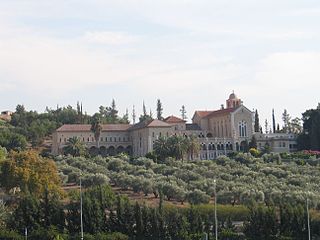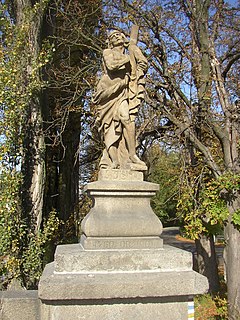
Latrun is located at a strategic hilltop in the Latrun salient in the Ayalon Valley. It overlooks the road between Tel Aviv and Jerusalem, 25 kilometers west of Jerusalem and 14 kilometers southeast of Ramla. It was the site of fierce fighting during the 1948 war. During the 1948–1967 period, it was occupied by Jordan at the edge of a no man's land between the armistice lines known as the Latrun salient. In the 1967 war, it was captured by Israel along with the whole salient and the West Bank, and remains a part of Israel to this day.
The Conestoga Parkway is a freeway in the Regional Municipality of Waterloo, in the Canadian province of Ontario. It runs northeast/southwest through the cities of Kitchener and Waterloo, and is connected to Highway 401 via the Highway 8 Freeport Diversion and King Street East. The name "Conestoga Parkway" is not a formal designation, but rather a local name applied to the divided expressway portions of Highway 7, Highway 8 and Highway 85 through Kitchener and Waterloo. When the parkway opened in the late 1960s there were a few large green and white signs reading "Conestoga Parkway" with a picture of a Conestoga wagon on them located along the parkway. By the 1990s after several sections of the parkway had undergone reconstruction and expansion, these signs had been removed but many maps still show this as the name of the freeway. Most residents of Kitchener and Waterloo refer to the parkway as "The Expressway". By contrast, the portion of Highway 8 which departs from the parkway at King Street East in Kitchener and runs to Highway 401 is often referred to as "The Highway 8 Expressway" by local residents.

A cloverleaf interchange is a two-level interchange in which left turns are handled by ramp roads. To go left, vehicles first continue as one road passes over or under the other, then exit right onto a one-way three-fourths loop ramp (270°) and merge onto the intersecting road. The objective of a cloverleaf is to allow two highways to cross without the need for any traffic to be stopped by red lights, even for left and right turns. The limiting factor in the capacity of a cloverleaf interchange is traffic weaving.

The Megiddo Junction is an intersection of Highways 65 and 66 in northern Israel, at the exit from the mountain pass coming up through Wadi Ara into the Jezreel Valley. It is named for the nearby ruins of the biblical city of Megiddo, also known as Armageddon, and the sites of several historic battles. Adjacent to the junction is the large Megiddo Prison, and less than a kilometre to the northwest is kibbutz Megiddo.

Grade separation is a method of aligning a junction of two or more surface transport axes at different heights (grades) so that they will not disrupt the traffic flow on other transit routes when they cross each other. The composition of such transport axes does not have to be uniform; it can consist of a mixture of roads, footpaths, railways, canals, or airport runways. Bridges, tunnels, or a combination of both can be built at a junction to achieve the needed grade separation.

A diamond interchange is a common type of road junction, used where a freeway crosses a minor road.

In the field of road transport, an interchange is a road junction that uses grade separation, and typically one or more ramps, to permit traffic on at least one highway to pass through the junction without interruption from other crossing traffic streams. It differs from a standard intersection, where roads cross at grade. Interchanges are almost always used when at least one road is a controlled-access highway or a limited-access divided highway (expressway), though they are sometimes used at junctions between surface streets.

A stack interchange, or colloquially butterfly junction, is a particular, free-flowing type of design for interchanges, meaning grade-separated road junctions. It is referred to as a directional interchange in the American Association of State Highway and Transportation Officials Policy on Geometric Design of Highways and Streets.

Highway 1, is the main highway connecting Tel Aviv and Jerusalem in Israel and continuing eastwards to the Jordan Valley.

Modi'in-Maccabim-Re'ut is an Israeli city located in central Israel, about 35 kilometres (22 mi) southeast of Tel Aviv and 30 kilometres (19 mi) west of Jerusalem, and is connected to those two cities via Highway 443. In 2017 the population was 91,328. The population density in that year was 1,794 people per square kilometer.

Highway 50, officially called Begin Boulevard and also referred to as Menachem Begin Expressway or Begin Highway, is an urban freeway in western Jerusalem named after Israel's sixth Prime Minister, Menachem Begin. Local Jerusalemites simply refer to it as 'Begin'. It continues into the Palestinian territories.

Route 443 is also known as Ma'ale Beit Horon, following the ancient east-west trade route connecting the Via Maris and the Way of the Patriarchs. It is the main highway connecting Tel Aviv and Gush Dan with Jerusalem via Modi'in. While technically listed as a regional road, it is for the most part a divided, four-lane highway which utilises some grade separation and interchanges, as well as major at-grade intersections, and thus is not classified as a motorway, even though there is a short motorway section on its western end, connecting it to westbound Highway 1.
Interstate 15 (I-15) runs north–south in the U.S. state of Utah through the southwestern and central portions of the state, passing through many of the population centers of the state, including St. George, Provo, Salt Lake City, and Ogden, the latter three being part of the urban area known as the Wasatch Front. It is the primary north–south highway in Utah, as the majority of the state's population lives along its corridor. The only Metropolitan Statistical Area in Utah not connected by I-15 is the Logan Utah-Idaho Metropolitan Statistical Area. In 1998, the Utah Legislature designated the entire length within Utah as the Veterans Memorial Highway.

Highway 3 is a highway in Israel. It begins at Highway 4 on the outskirts of Ashkelon, running east-northeast, passing through Kiryat Malakhi and Latrun, and ending just short of Modi'in.

Highway 7 is a highway in the South District of Israel from Ashdod to Yesodot. It connects the Port of Ashdod with the Trans-Israel Highway.

Highway 38 is an arterial road in the low plains of Judea in Israel. It serves as the main access route to Beit Shemesh and as a main north-south route in the region. Along the route are many nature preserves and archeological sites.

Highway 41 is an arterial road in south-central Israel. It connects Highway 4 and Highway 7 to the Port of Ashdod. The designation "41" also applied to the continuation of the road eastward to Gedera until that section of the road was upgraded and renamed "7".

Highway 44 is an arterial road in central Israel. It connects Tel Aviv-Yafo and Holon to Ramla, Lod and the Shefela.

Terminology related to road transport—the transport of passengers or goods on paved routes between places—is diverse, with variation between dialects of English. There may also be regional differences within a single country, and some terms differ based on the side of the road traffic drives on. This glossary is an alphabetical listing of road transport terms.






























